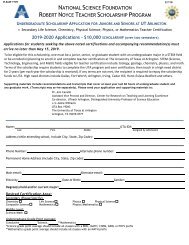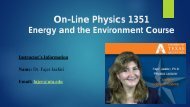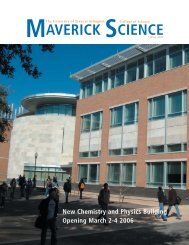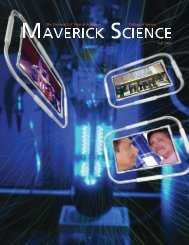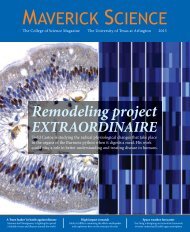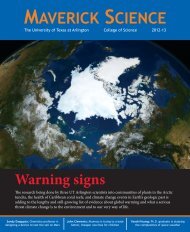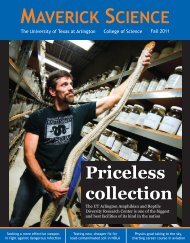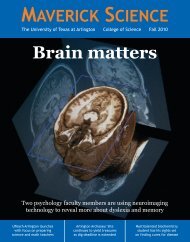Maverick Science mag 2013-14
You also want an ePaper? Increase the reach of your titles
YUMPU automatically turns print PDFs into web optimized ePapers that Google loves.
The Laramide Orogeny deformed<br />
the foreland basin of the<br />
Sevier fold-thrust belt into a<br />
high orogenic plateau with high<br />
relief during the Late Cretaceous<br />
through the Eocene epoch, Fan<br />
said. The Sevier orogeny was a<br />
mountain-building event that<br />
affected western North America<br />
from what is now Canada in the<br />
north to what is now Mexico in<br />
the south, and was caused by<br />
tectonic plate activity between<br />
<strong>14</strong>0 and 50 million years ago.<br />
The current model is too simple<br />
to explain the great duration of<br />
the Laramide Orogeny – around<br />
40 million years – and the internal<br />
connections among the regional<br />
tectonic units and<br />
processes in the western United<br />
States, Fan said.<br />
“We are combining multidisciplinary<br />
basin analysis – sedimentology,<br />
stratigraphy, isotope<br />
paleoaltimetry, and detrital geochemistry<br />
– and basement apatite<br />
fission track thermochronology<br />
to reconstruct the<br />
temporal and spatial patterns of<br />
Laramide uplift,” Fan said. This<br />
work has led to an accepted paper in the journal Tectonics.<br />
A<br />
fter earning a B.S. in Geology from Lanzhou University<br />
in China in 2000, Fan decided to begin graduate school.<br />
The summer before starting work on her master’s degree<br />
at Lanzhou, she got the chance to participate in a collaborative<br />
project between Lanzhou and the University of<br />
Arizona. The study’s goal was to understand the tectonic<br />
processes forming the high Tibetan Plateau by studying<br />
the sedimentary rocks preserved in topographic lows,<br />
called sedimentary basins, in northwestern China. She worked as a field assistant<br />
for two University of Arizona researchers over that summer and the<br />
next.<br />
“I learned from these two knowledgeable geologists way more than the<br />
help I could provide at that time,” she said. “I was particularly impressed by<br />
their broad ranges of interest in nature, their determination to pursue a multidisciplinary<br />
approach to solve problems, their diligent work habits, and<br />
their patience with students. They became my role models, and the experience<br />
shaped my professional track significantly.”<br />
After earning an M.S. from Lanzhou in 2003, she applied for and was accepted<br />
to the University of Arizona for further graduate work. She earned a<br />
master’s in Geoscience in 2005 and then began work on her Ph.D. in Geoscience.<br />
In the summer of 2009, she worked as an intern geologist with<br />
ExxonMobil in Houston. She completed her<br />
Ph.D. the following semester while also working<br />
as a lecturer at Arizona, then spent the next 18<br />
months as a postdoctoral fellow at the University<br />
of Wyoming. In early 2011, she interviewed<br />
for a faculty position at UT Arlington and was<br />
impressed with the diversity of the faculty and<br />
students. She started in August 2011 as an assistant<br />
professor.<br />
“Their diversity represents different perspectives<br />
to shape our campus culture,” she<br />
said. “When I was interviewed in the spring of<br />
2011, the minute I saw the diverse populations<br />
walking around the green campus in the warm<br />
early spring, I said to myself this<br />
is the place I would be very<br />
happy to be.”<br />
Fan’s<br />
students<br />
love working<br />
with her because<br />
she is supportive<br />
and<br />
eager to help<br />
them succeed.<br />
Ohood Al salem, a second-year<br />
master’s student in Fan’s lab, is<br />
studying the history of subsidence<br />
(the sinking of the<br />
Earth’s surface due to geologic<br />
causes) of the Fort Worth<br />
Basin, which was formed 280 to<br />
250 million years ago by the<br />
collision between the supercontinent<br />
Gondwana and Laurentia,<br />
a large, stable portion of<br />
continental craton (part of a<br />
continental lithosphere) which<br />
forms the ancient geological<br />
core of the North American<br />
continent.<br />
“The subsidence history of<br />
the Fort Worth Basin is not only<br />
important to the understanding<br />
of tectonic processes during the<br />
collision, but also to the maturation and migration of oil and gas in the basin,”<br />
Fan said.<br />
Al salem plans to complete her master’s degree this spring and then hopes<br />
to begin work on a doctoral degree, with Fan as her mentor.<br />
“Dr. Fan is the best mentor. She always offers help and support to her students,”<br />
Al salem said. “She is a very hard worker and very talented, which<br />
gives me the motivation to do my best in my research. That’s why I really<br />
want to do my Ph.D. with her. I believe our work together will lead to excellent<br />
scientific research.”<br />
Sara Ayyash, a first-year master’s student, is studying rock samples collected<br />
by Fan from the White River Formation near Douglas, Wyoming, to<br />
learn more about the paleoclimate and paleoenvironment during the late<br />
Eocene and early Oligocene epochs, approximately 34 million years ago.<br />
“Dr. Fan is extremely dedicated to her work and teaching,” Ayyash said.<br />
“You can tell that she truly enjoys learning new things or subjects that she is<br />
not familiar with. She puts a tremendous amount of effort into what she does,<br />
whether it’s teaching or research and it shows during lectures or when you<br />
speak with her.”<br />
Fan finds her work as a geoscientist fulfilling and enjoys taking the knowledge<br />
she has acquired and passing it on to her students and helping them as<br />
they embark on their careers.<br />
“Because research is the only way to advance knowledge created in the<br />
past, I feel excited about the role I am playing in advancing knowledge,” Fan<br />
said. “I enjoy passing knowledge along in a variety<br />
of ways to students, and spending time<br />
with students in the classroom, lab, and field in<br />
order to help them gain the skills to make geologic<br />
observations, interpretations, and discoveries.Geology<br />
offers me the opportunity to<br />
conduct fieldwork and examine the Earth with<br />
colleagues and students in the wilderness. Such<br />
experiences are very rewarding because we discover<br />
the beauty of nature that most people do<br />
not see and forge long-term relationships.<br />
“Doing geology research is sometimes challenging.<br />
However, once in a while, I discover<br />
something that takes my breath away.” n<br />
Above, Fan uses a pen for scale next to a sandstone formation showing climbing ripples,<br />
located in the Wind River Basin of Wyoming. Below, Fan shows Aragonitic freshwater<br />
bivalve fossils found in the early Eocene Wasatch Formation on the west side<br />
of the Powder River Basin of Wyoming. The oxygen isotope ratio of the fossil will be<br />
used to collect information regarding the paleoelevation of the mountains bounding<br />
the basin. Photos courtesy of Majie Fan.<br />
<strong>Maverick</strong> <strong>Science</strong> <strong>2013</strong>-<strong>14</strong><br />
23



